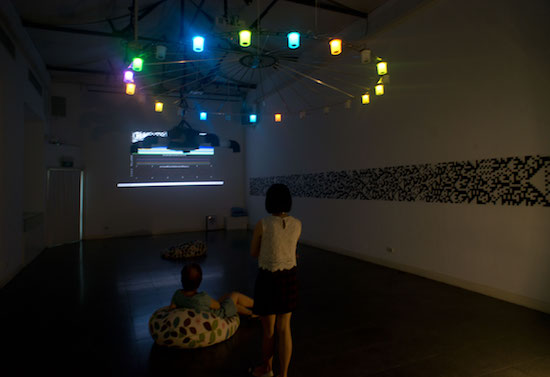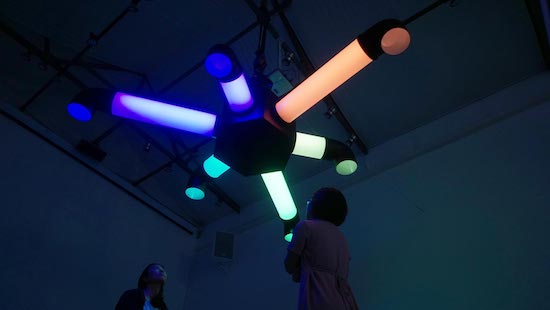From the humid bustle of a still-hot autumnal Hanoi, entering the Goethe-Institut in the upscale Ba Đình district feels like an oasis of calm. Past a series of small images (Spectral Revision, 2013-16) based on the colour intensity discoveries of Joseph von Fraunhofer but resembling the colour field painting of Barnett Newman or Jack Bush, the visitor enters a long rectangular hall, and relaxes on the cushioned surface of a giant beanbag. From there you are immediately swept up in a whirling susurrus of light and sound as the installation over your heard starts to spin and a cascade of sine tones melt and merge in dazzling iridescence.
I first met Tim Otto Roth at the ZKM in Karlsruhe back in 2012. I was there to attend a conference on ‘neuroaesthetics’. He had a sound installation called Sonapticon: forty-two dinner plate-sized discs of light shivering and pulsating on the floor, emitting a series of stuttered, syncopated pulses that build into a micro-tonal Mexican wave of electronic sounds that Roth described as a klangteppich – a ‘sound carpet’.
Born in the small Black Forest town of Oppenau in 1974, Roth artistic career began with a formal enquiry into the technical basis of photography. In 2014, he finally completed his PhD, and a year later published his research on the ‘cultural history of shadow pictures’ through Wilhelm Fink Verlag. Meanwhile, he has worked alongside the European Space Agency, Fermilab, and the Max Planck Institute to produce a series of immersive installations in which physics and aesthetics work together in startling new combinations.
I was fortunate to catch Roth’s latest installation, his first in South-East Asia, on a recent trip to Hanoi. Later, I caught up with him to ask how it all came about.
What were your first thoughts in approaching this show? And how did that develop into the piece I saw the other week?
Well, the first thoughts to present these two works came up from looking to the plans of the space I got sent last winter. The shoe box character is perfect for sound works and the space is high enough to present works pending from the ceiling. In early summer I worked out a detailed exhibition design with the additional projection and the wall paper. Technically there was still a couple of things to develop and to build, the lustre design etc. Above all, I ran extended computer simulations for aura calculata to get an idea of its dynamics.
Can you explain the way it actually worked – on a practical level – in a little bit more detail?
The acoustic principle is similar to the one I used in 2012 for the Sonapticon in the ZKM’s sound dome. I am using discrete tone sources (almost sine tones), using space as a kind of synthesizer, where discrete sine tones mix up to site specific sounds. Deep Doppler adds the element of motion, which brings also a slight doppler effect into play, but first of all it plays with the changing reflections of the deep tones by the wall and the floor (standing waves). Deep Doppler> is a special horn construction using the air columns in the tubes as a kind of physical amplification.
Both works start with the standard tone A at 440hz. The harmonics of both works are based on scales beyond the traditional twelve-tone systems. Aura calculata starts with a non-octavating Bohlen-Pierce scale changing at the end to a seventeen-tone scale developed by the Russian composer Ivan Wyschnegradsky in 1934. This scale is used also by Deep Doppler, exploring microtonal intervals especially at deep frequencies (down to around twenty-three hz) using the same intervals as in the beginning of the piece starting at 440 hz. At the end of the piece a special component of the loudspeaker’s construction comes into play: The membranes are all fixed to the same hexagonal resonance body, so they also influence each other. Especially at deep frequencies they really push and pull against each other. This gives a very physically touching component to the finale.
As you say, this work continues in a way, the work you were doing when we first met at the ZKM, but can you just say a few words about how this piece is kind of an advance on, or isdifferent from the Sonapticon project?
The recent installations are not really an advance, but they just move in different directions.
The self-organizing principle behind the Sonapticon is a neuro-biological model driving the activity of the audio neurons. Aura calculata is based on a much simpler model called cellular automata. Although the interaction is based just on the binary logic of active/non-active, the resulting spatio-temporal pattern is quite stunning.
Motion is another central element of the Sonapticon. The tones travel in the studio space bringing also runtime effects into play. The use of sine waves for the Sonapticon was first of all a technical necessity to track the activity of a loudspeaker tagged with a specific frequency. But moving in the Sonapticon confronted me with continuously changing recompositions of the tones to local sounds. This inspired me to reverse the concept of motion: Not to move the audience in the installation, but to bring the sound sources physically into motion. This idea I realized for the first time with the Heaven’s Carouseland now with Deep Doppler. The resulting physical motion creates a new quality of additive sound composition in space you can never simulate by placing virtual sound sources in static multi-channel systems.

As I understood it the sequence of tones that we hear in the installation wasn’t composed intuitively, but rather is the result of a recursively applied operation or algorithm. Can you just explain what that operation is and how you arrived at that particular sum?
A dynamic recursion applies indeed to aura calculata, whereas Deep Doppler is based on a quite static composition principle based on the expansion and contraction of micro intervals at very low frequencies. Starting with the standard pitch at 440 hz, Deep Doppler creates a series of descending intervals based on a seventeen-tone scale, expanding until it reaches a very deep resonating bass frequency. Then the whole intervals re-contract around this bass tone. This activity is represented also by the spectral colour illumination of the tubes: The colours start with a blue/violet tone for the highest pitch and ends up with a deep red. Above all, this illumination amplifies the psychedelic impression, if you lay under and look up to the turning lights.
With aura calculata, the activity and the pitch of the tones are the dynamic result of a simple rule of self-organization: Each loudspeaker unit – a “sound pixel” – obeys the same rules on how to react to its neighbour’s activity – the same principle driving the “wave” in a stadium. A simple modification is to take out the directionality of the “wave” rule, saying that a sound pixel will be active in the next step, if in the previous step either its left or right neighbour was active. The resulting activity pattern you find reproduced as a twelve metre long tessellated wall paper in the exhibition, which you can read like a score column-wise from the left to the right.
But aura calculata is more than switching tones on or off. As you can hear, the tones are continuously changing. Here I developed a special statistical analysis, translating the changing activities of the agents into changing pitches. Interestingly, the activity profile changes with the number of units in the ring like topology. This is why aura calculata consists of twenty-three units producing a very robust spatio-temporal pattern.
Finally, as a further compositional element, I can change the neighbour rules resulting in very different activity patterns, which can be followed in the video projection displaying the activity of the last fifty steps. Acoustically, a change of rule is expressed by switching between a sine, square, or triangular wave form of the tones.
What do you mean by “mathematical socialism”?
Aura calculata is a kind of formal test of a core principal of socialism: It is the concept of equality. Whereas in reality you can never establish equal conditions, you can do it in the formal environment of mathematics very well. And that happens in aura calculata. Every agent is 100% equal, behaving according to the same rules, how to react on the two neighbouring agents.
Interestingly, if you look to the behaviour of the entire community of agents, the result is not necessarily a uniform activity in lockstep, where every member shows the same activity. In the end, you see that individual members might freak out and show a deviating activity profile. This allows aura calculata to weave a continuously recomposing sound carpet. So at least in the realm of mathematics and music, equality does not necessarily end up in uniformity.
Tim Otto Roth, Circulating Sounds, was at the Goethe-Institut, Hanoi, from 13 October to 3 November. More on Tim Otto Roth’s work can be found at the Imachination Projectswebsite


